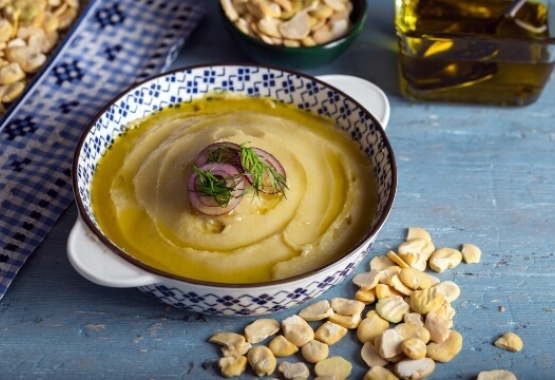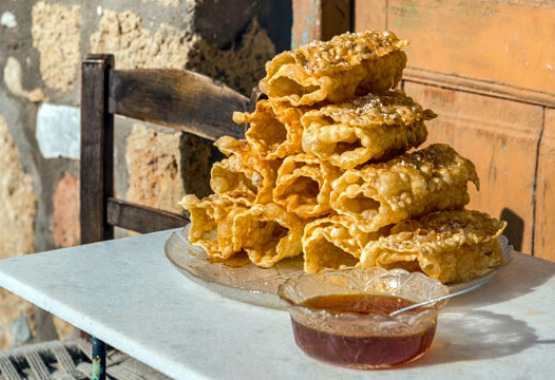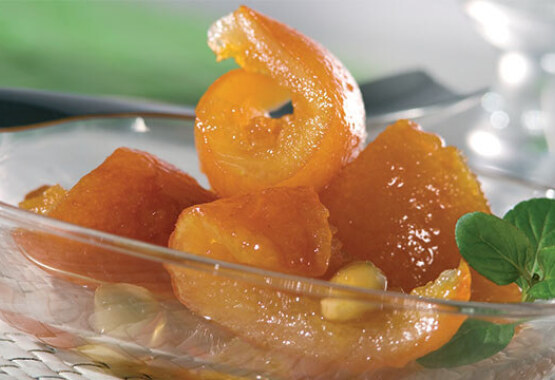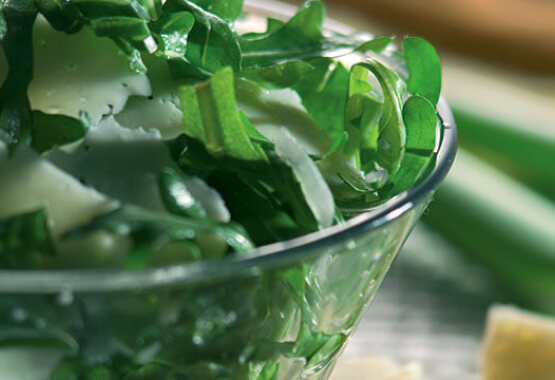
AROUND GREECE
On Tinos Island people add petimezi (grape molasses) to their food, which lends their creations a particular flavour. Other dishes you'll love are: red mullets with a barley rusk crust on Mytilini, Lesvos Island; oven-baked fish with sesame paste (tachini) on Rhodes Island; chub mackerel with capers; grouper stew with onions; kakavia soup (made with rockfish); picarel omelette on Santorini and Syros Islands; a fish pie made with Mediterranean sand smelt on Kimolos Island; stuffed squid with rice or feta cheese, cuttlefish with fennel and olives, to name but a few…
Make sure you also taste some special mezedes (meaning titbits) with your tsipouro or ouzo drink, such as salt-cured sardines from Mytilini, grilled sun-dried chub mackerel (gouna) from Paros Island, a salad with herring roe from Syros Island, marinated anchovies and salt-cured tuna.
Taste savoury mezedes that are best enjoyed with some Greek strong red wine, such as syglino (smoked pork bits in lard); apaki (cured pork lean fillet); kavourmas (cooked pork / beef / lamb bits preserved in fat), and all kinds of sausages served as chopped pork bites with lots of herbs.
Santorini’s most famous and must-try dish is fava (yellow split peas); sadly, a pulse threatened with extinction. It is served with coarsely chopped onions, oregano, capers and extra virgin olive oil. Make sure you also try the tasty croquettes made with chickpeas or yellow split peas which are mashed and mixed with spring onions, spearmint, parsley, and flour, and seasoned with salt and pepper.
You can savour similar wine-cheeses on Nisyros and Leros Islands. Sitaka is a speciality cheese made on Kasos Island, one of the most particular dairy products in Greece: it is a tart, creamy cheese made with goat or sheep’s fermented milk, slightly salted and baked in low temperatures in a traditional oven. Sitaka is often served on delicious locally made pasta with caramelized onions. Other must-try cheeses are San Michali, a PDO Syros Island cheese; and chloro, a Santorini cheese, which is eaten either fresh and soft or aged, on pasta dishes. Last but not least, make sure you taste some of the graviera (gruyere) varieties produced on Crete Island. Discover them and many more flavours during your trips across the Aegean Islands.
Enjoy!
Aegean Cuisine
Delightful Flavours from the Aegean Sea
Your journeys around the Aegean Sea and the islands you visit will steal your heart with their captivating local scents and delicious flavours. Welcome to the Aegean Sea’s world of taste: rich white or red sauces; tenderly cooked pulses; home-grown tasty vegetables traditionally grown on dry soil; bread and rusks with the robust flavour of the local wheat and barley varieties; and fresh goat cheeses, as filling to fluffy little pies wrapped in thin dough, are some of your options as you follow our gastronomic map of the area.Main Ingredients: Sea & Sun
The Aegean Sea and Islands have been shaped by the sun, the sea and the invigorating winds. The local culinary traditions date back to ancient times and they are an intrinsic part of the Aegean Culture. Top quality ingredients wear the aromas of the earth: oregano, thyme, bay leaves, rosemary, lemons, and olive oil. Each island’s microclimate has contributed to the growth of flavourful produce, some of which are unique across the world.Greens & Aromatic Plants
The Aegean landscape hides fragrant and tasty surprises to visitors who want to explore its rough barren hills and volcanic soil, its olive groves that grow on dry soil and its rocky shores. Savour boiled greens picked from the mountains, sprinkled with olive oil and lemon juice as a side dish to your grilled meat or fish dish. A large variety of aromatic plants and herbs, such as oregano, savory, marjoram and thyme flavour marinades and stews cooked in lemon sauce. Capers and crithmum (rock samphire) are two wild plants that thrive by the seashore and they make some excellent appetizers to enjoy with your tsipouro drink.Fresh Fish & Seafood Appetizers
Fish can be cooked in various ways as long as you use your imagination… and in this department Greeks fare well. Small or medium sized fish are floured and fried in sizzling olive oil which turns them into crispy treats, sometimes served along with a tasty sourish marinade-sauce called ‘savoro’. To make this sauce locals use olive oil, quality vinegar, rosemary, and oregano – it’s the standard recipe on most of the islands.On Tinos Island people add petimezi (grape molasses) to their food, which lends their creations a particular flavour. Other dishes you'll love are: red mullets with a barley rusk crust on Mytilini, Lesvos Island; oven-baked fish with sesame paste (tachini) on Rhodes Island; chub mackerel with capers; grouper stew with onions; kakavia soup (made with rockfish); picarel omelette on Santorini and Syros Islands; a fish pie made with Mediterranean sand smelt on Kimolos Island; stuffed squid with rice or feta cheese, cuttlefish with fennel and olives, to name but a few…
Make sure you also taste some special mezedes (meaning titbits) with your tsipouro or ouzo drink, such as salt-cured sardines from Mytilini, grilled sun-dried chub mackerel (gouna) from Paros Island, a salad with herring roe from Syros Island, marinated anchovies and salt-cured tuna.
Fine Meats
Wild goats (known as fouriarika on Crete Island) roam on the Aegean Islands; they feed on the scant flora and they drink brackish water from springs flowing near the sea: this is why their meat is flavourful and it is used in many dishes. It’s cooked with wild greens (a dish called frikase) or with seasonal vegetables such as lettuce, artichokes, courgettes, fresh broad beans and aubergines. A light tomato sauce is usually added or a savoury egg & lemon sauce. Try mastelo (lamb casserole with herbs and wine), kapama from Rhodes Island (goat meat stuffed with rice), vyzanti from Karpathos Island (oven baked stuffed lamb) and pilafi – a risotto-like dish from Kasos Island.Taste savoury mezedes that are best enjoyed with some Greek strong red wine, such as syglino (smoked pork bits in lard); apaki (cured pork lean fillet); kavourmas (cooked pork / beef / lamb bits preserved in fat), and all kinds of sausages served as chopped pork bites with lots of herbs.
Pulses
You can find black eyed beans, string beans, chickpeas, tiny fava beans, split yellow peas, lupins and green peas on most of the Aegean Islands. The most famous dish on Sifnos Island is a chickpea casserole (called revithada). The pulses are placed in an earthenware casserole, with a generous amount of olive oil, finely chopped onions, bay leaves or oregano, then the pot lid is sealed with dough, and the casserole is put in the oven (usually a traditional outdoor oven), where the food is slowly cooked for many hours (preferably the entire night).Santorini’s most famous and must-try dish is fava (yellow split peas); sadly, a pulse threatened with extinction. It is served with coarsely chopped onions, oregano, capers and extra virgin olive oil. Make sure you also try the tasty croquettes made with chickpeas or yellow split peas which are mashed and mixed with spring onions, spearmint, parsley, and flour, and seasoned with salt and pepper.
Savoury Cheeses
The Aegean Islands are famous for their delicious cheese made from goat and ewe’s milk. On Sifnos and Folegandros Islands taste manoura cheese that ripens in wine sediment. Kalathaki (meaning small basket) is a white salty goat cheese from Limnos Island that takes its shape and name by the wicker basket in which it matures. On Kos Island try krasotyri, a ridged, log-like form wine-cheese.You can savour similar wine-cheeses on Nisyros and Leros Islands. Sitaka is a speciality cheese made on Kasos Island, one of the most particular dairy products in Greece: it is a tart, creamy cheese made with goat or sheep’s fermented milk, slightly salted and baked in low temperatures in a traditional oven. Sitaka is often served on delicious locally made pasta with caramelized onions. Other must-try cheeses are San Michali, a PDO Syros Island cheese; and chloro, a Santorini cheese, which is eaten either fresh and soft or aged, on pasta dishes. Last but not least, make sure you taste some of the graviera (gruyere) varieties produced on Crete Island. Discover them and many more flavours during your trips across the Aegean Islands.
Enjoy!




